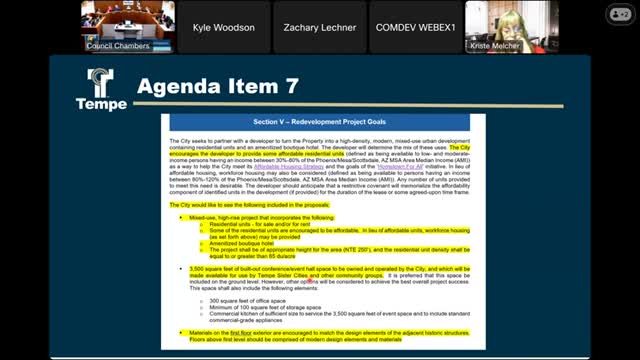City debates controversial 20 story high rise development plan
July 11, 2024 | Tempe, Maricopa County, Arizona

This article was created by AI summarizing key points discussed. AI makes mistakes, so for full details and context, please refer to the video of the full meeting. Please report any errors so we can fix them. Report an error »

In a recent government meeting, city officials and planning commissioners expressed significant concerns regarding a proposed high-rise development that could reach up to 250 feet and house 65 dwelling units per acre. The discussions highlighted the potential impact of a 20-story building on the surrounding historic structures, with some officials questioning the decision-making process that led to such a high-density proposal in a location deemed inappropriate.
One commissioner voiced confusion over the rationale for the development, emphasizing the lack of prior consultation before the proposal was issued. Concerns were raised about the absence of parking requirements for the high-rise, with officials questioning how residents would manage parking in a densely populated area. The response indicated that the city plans to rely on existing public parking facilities, suggesting a shift in urban planning philosophy that prioritizes pedestrian-friendly designs over traditional parking structures.
Another commissioner, drawing from experience in other cities, noted that high-rise developments often integrate historic buildings into their designs, which could mitigate some concerns. However, the lack of a clear design or selected project at this stage left many questions unanswered.
The meeting also revealed a stark contrast in planning approaches, as officials compared the high-rise proposal to a previous project that required extensive parking for a much smaller building. This inconsistency raised frustrations among commissioners, who felt that the divergent requirements lacked justification.
As the city moves forward with the proposal, officials acknowledged the need for careful consideration and input from the Historic Preservation Commission (HPC) to address the potential impacts on the community and its historic character. The discussions underscored the complexities of urban development and the balancing act between growth and preservation.
One commissioner voiced confusion over the rationale for the development, emphasizing the lack of prior consultation before the proposal was issued. Concerns were raised about the absence of parking requirements for the high-rise, with officials questioning how residents would manage parking in a densely populated area. The response indicated that the city plans to rely on existing public parking facilities, suggesting a shift in urban planning philosophy that prioritizes pedestrian-friendly designs over traditional parking structures.
Another commissioner, drawing from experience in other cities, noted that high-rise developments often integrate historic buildings into their designs, which could mitigate some concerns. However, the lack of a clear design or selected project at this stage left many questions unanswered.
The meeting also revealed a stark contrast in planning approaches, as officials compared the high-rise proposal to a previous project that required extensive parking for a much smaller building. This inconsistency raised frustrations among commissioners, who felt that the divergent requirements lacked justification.
As the city moves forward with the proposal, officials acknowledged the need for careful consideration and input from the Historic Preservation Commission (HPC) to address the potential impacts on the community and its historic character. The discussions underscored the complexities of urban development and the balancing act between growth and preservation.
View full meeting
This article is based on a recent meeting—watch the full video and explore the complete transcript for deeper insights into the discussion.
View full meeting
